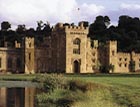History reset in stone
Herefordshire’s largest medieval manor house prepares to take on a new incarnation


The sale, announced today, of historic, Grade I-listed Hampton Court, near Leominster in scenic north Herefordshire, highlights a remarkable turnaround in the fortunes of the county?s largest medieval manor house. Knight Frank (020?7629 8171) quote a guide price in the region of £10 million for the impeccably restored 25-bedroom mansion and its surrounding 946-acre estate, which is being offered either as a whole, or in up to four lots.
Hampton Court?s prospects looked rather less rosy some 30-odd years ago, when the late John Cornforth, architectural editor of Country Life, lamented the sale of the Hereford family seat and the dispersal of its contents in a series of articles (Country Life, February 22, March 1 and 8, 1973) which he dubbed ?a form of obituary?.
Mr Cornforth remarked sadly: ?Lord Hereford?s departure probably marks the end of Hampton Court as a family house . . . Captain Smith (the new owner) does not intend to live in it, and at the present time no decision has been taken as to its future?, adding, ?the vast area of roof and of peeling stonework make it a daunting problem and could put a damper on any scheme for an alternative use.
Whatever solution is found, I hope that at least the north range survives intact, for it is still both impressive as a composition and evocative of an immensely long and fascinating history.? A history vividly reflected in the changes made to the house by successive owners over the years.
The earliest records of the Hampton Court Estate date from 1243; a century and a half later, it was owned by Henry Bolingbroke, Earl of Hereford, who became Henry IV in 1399. He began construction of a quadrangle manor house in the early 1400s, before granting the estate to a courtier, Roland Leinthall, who completed the project and was authorised to ?crenellate, turrelate and embattle the manor, and to impark 1,000 acres of land?.
In 1510, Henry VIII?s sergeant-at-arms, Sir Humphrey Coningsby, bought the estate for his eldest son, Thomas, who remodelled the house and laid out the first great gardens at Hampton Court in the early 1700s. A second reconstruction was carried out in the 1790s for the future 5th Earl of Essex.
A third, definitive, phase of reconstruction was undertaken in the 1830s and early 1840s by John Arkwright, grandson of the inventor and industrialist Sir Richard Arkwright, who bought Hampton Court in 1810. An extravagant rebuilding scheme by Charles Hanbury Tracy included a splendid conservatory by Joseph Paxton, and took eight years?and £27,500?to complete.
Sign up for the Country Life Newsletter
Exquisite houses, the beauty of Nature, and how to get the most from your life, straight to your inbox.
The Arkwrights lived at Hampton Court until 1912, when the house and most of its original contents were bought by Mrs Nancy Burrell, and then in 1924 by Viscountess Hereford.
After 1973, Hampton Court continued its slow decline until in 1994, the estate was bought by the late Robert Van Kampen, the billionaire American industrialist, who immediately set in train a massive programme of restoration and renovation, which included the installation of state-of-the-art heating, electrical and communications systems.
Currently used as a spectacular venue for conferences and weddings, highlights of today?s Hampton Court include the 19th-century banqueting hall, the
cloisters, the 15th-century chapel, the ballroom, the library, the grand panelled dining room, and a cantilevered, early-18th-century, stone staircase?built for
a visit by William of Orange and said to be the longest such staircase in the country?and Paxton?s orangery, now used as a restaurant.
The accommodation also includes a number of private reception rooms,
16 bedrooms and 14 bathrooms on the first floor, and a further 10 bedrooms and 10 bathrooms on the second. There is planning consent to convert the upper floor of the gatehouse to a two-bedroom guest suite.
An equally ambitious project by landscape designer Simon Dorell has transformed Hampton Court?s famous gardens and grounds?now open to the public?where a small army of estate masons and carpenters has rebuilt many of the original structures and added new ones. Wonders include an ornamental kitchen garden, an enchanting flower garden with a 150-year-old wisteria, a Dutch pool garden, a yew maze with a central Gothic tower, and a delightful sunken garden with a thatched hermitage and a waterfall.
For selling agent Tim Jessop of Knight Frank, the new Hampton Court, with its 350 acres of woodland, its farmhouses, cottages and outbuildings, and its fishing on the River Lugg, is ?the ultimate trophy estate?.
Country Life is unlike any other magazine: the only glossy weekly on the newsstand and the only magazine that has been guest-edited by HRH The King not once, but twice. It is a celebration of modern rural life and all its diverse joys and pleasures — that was first published in Queen Victoria's Diamond Jubilee year. Our eclectic mixture of witty and informative content — from the most up-to-date property news and commentary and a coveted glimpse inside some of the UK's best houses and gardens, to gardening, the arts and interior design, written by experts in their field — still cannot be found in print or online, anywhere else.
-
 Vertigo at Victoria Falls, a sunset surrounded by lions and swimming in the Nile: A journey from Cape Town to Cairo
Vertigo at Victoria Falls, a sunset surrounded by lions and swimming in the Nile: A journey from Cape Town to CairoWhy do we travel and who inspires us to do so? Chris Wallace went in search of answers on his own epic journey the length of Africa.
By Christopher Wallace
-
 A gorgeous Scottish cottage with contemporary interiors on the bonny banks of the River Tay
A gorgeous Scottish cottage with contemporary interiors on the bonny banks of the River TayCarnliath on the edge of Strathtay is a delightful family home set in sensational scenery.
By James Fisher